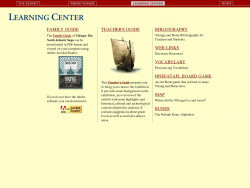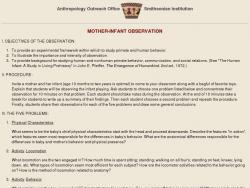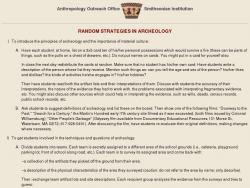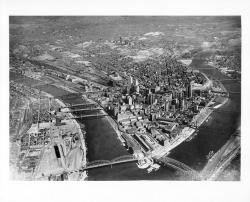Kate Harris
Social Studies teacher
Pittsburgh CAPA
Middle School (13 to 15 years old), High School (16 to 18 years old)
Teacher/Educator
Language Arts And English, Civics, Literature, Cultures, Economics, Social Studies, Geography, Writing, US History, Arts, Other
I'm a history-lover, art fan, and bookworm. I taught high school history (U.S. History and World Religions) for ten years in North Carolina, teach currently in Pittsburgh, PA, and am working to help teachers make the most of this new resource!
Kate Harris's collections
Ancient Egypt: A Variety of Artifacts
A topical collection to be used for student research projects.
 Kate Harris
Kate Harris
55
The Mexican-American War: Before, During, and After
The purpose of this collection is to have students consider the causes and consequences of the Mexican-American War. Students will analyze each item in the collection and determine whether it represents the time period before the war, during, or after. Then students will answer a set of broad questions about the war. While most items in the collection have accompanying text, students may need to consult their textbooks or outside resources in order to answer some questions.
 Kate Harris
Kate Harris
18
The Remains at Pompeii
This is a collection of teaching resources that could be used to support a lesson on Pompeii and Mt. Vesuvius as well as life in ancient Rome. Included are artworks picturing Pompeii, archaeological artifacts, and links to "street views" of the ruins as well as magazine articles on the topic.
Some questions to consider are:
-What can we learn about the life of ancient Romans from the ruins at Pompeii?
-What are the strengths and weaknesses of learning from archaeological ruins?
-Why have the ruins at Pompeii continued to fascinate people over time?
 Kate Harris
Kate Harris
12
The Middle Ages: Discover the Story
This collection includes objects and artifacts representing life in the Middle Ages. Students are challenged to write a creative story or narrative based on the objects in the collection, illustrating life at the time. The last two resources in the collection are a worksheet that teachers may use to frame the assignment and a grading rubric for the assignment.
 Kate Harris
Kate Harris
12
Remembering the Holocaust
This collection looks at the way artists have used art, literature, and architecture to memorialize the victims of the Holocaust and explores the questions around how an artistic work, memorial, or museum can try to convey an understanding of genocide.
Questions to keep in mind as you observe each work:
1) What is the purpose of this memorial? Is it to honor, remember, educate others, or something else?
2) On what aspect of the Holocaust does this memorial focus?
3) What Jewish symbols are present? What national symbols are present? Are there human figures? Is it abstract? What other features do you notice about this memorial?
4) What is the setting of this memorial? How does that affect its purpose and design?
 Kate Harris
Kate Harris
24
Westinghouse: The Man and the Companies
This is a collection of teaching resources available on the topic of George Westinghouse as well as Westinghouse Electric Company (founded 1886) and its spinoffs (including the broadcasting company and nuclear energy company).
Fun fact: During the 20th century, Westinghouse engineers and scientists were granted more than 28,000 US government patents, the third most of any company (https://en.wikipedia.org/wiki/Westinghouse_Electric_Company#cite_note-2009profile-14)
 Kate Harris
Kate Harris
15
What do Anthropologists Do?
There are a number of lesson plans devoted to anthropology available from the Smithsonian. This collection links to several of the best lessons and teaching resources and, where necessary, provides short summaries of what each are, so teachers can easily use them in their own classrooms.
It is focused on lessons and resources appropriate for middle and high school classrooms. The last four resources reference the case of Ishi, originally described as "the last Yahi Indian," and an example of flaws in the early approach to anthropology. The Smithsonian housed his brain, which had been donated to science by the University of California, from 1917 to 2000, when it was repatriated to his tribe.
 Kate Harris
Kate Harris
18
Civil Disobedience
<p>This is a topical collection on the concept of civil disobedience. Users are invited to explore the theme of civil disobedience through texts from Sophocles, Shelley, and Thoreau and a variety of images. </p><p>Questions to consider:</p><p>-Does civil disobedience pose a threat to society?</p><p>-What examples of civil disobedience are portrayed here? What are some other examples?</p><p>-What is the role of civil disobedience in today's society?</p><p>-Some people prefer the phrase "passive resistance" to "civil disobedience." Compare and contrast these two terms.</p><p>-How does one measure the success of an act of civil disobedience? Policy change? Public influence?</p><p>-What role does violence play in civil disobedience?</p><p>Tags: King, Gandhi, protest, Birmingham, Greensboro, suffrage, Boston Tea Party, Antigone, Masque of Anarchy, Tambo, nun, Randolph, civil rights, Mexican-American War, Goldman</p>
 Kate Harris
Kate Harris
17
Coffee Break
The best selection of coffee makers, urns, and mugs to be found in the Smithsonian collection. The best thing about waking up...
 Kate Harris
Kate Harris
23
Pittsburgh's Urban Renewal
<p>This collection was created to support a workshop on integrating primary sources and student writing for teachers at Peters Township High School. These resources can be used to design a document-based question to answer the following inquiry:</p><p>Were Pittsburgh's urban renewal programs in the 1950s and 60s ultimately helpful or harmful?</p><p>Teachers may want to excerpt the documents included in this collection before giving them to students to use. You may also want to introduce students to the concept of "purposeful annotation" as they read through the documents (resources included).</p><p>Finally, an articles on urban renewal today and a lesson plan from Global Oneness Project on gentrification and urban renewal in Seattle provide additional resources for teachers.</p><p>Tags: C3, Inquiry, urban renewal, demolition, construction, slums, Teenie Harris, Charles Olmstead, Pittsburgh</p>
 Kate Harris
Kate Harris
17
What were the causes of U.S. imperialism?
<p>This collection examines the causes of U.S. imperialism at the turn of the century through the lens of two political cartoons. Students will investigate both cartoons and develop a definition of imperialism based on what they find. </p>
 Kate Harris
Kate Harris
4
Six Degrees of Separation: An APUSH Review Activity
Use this collection as a starting point for an AP United States History review activity that emphasizes connections and cause-and-effect. Students will copy the collection and add in four resources that form a chain of connection from one item to another (ending with six resources total). For each resource, they should add an annotation describing each of the events or items included, analyzing any important details in the resources themselves, and explaining how each connects to the next one.
 Kate Harris
Kate Harris
2









